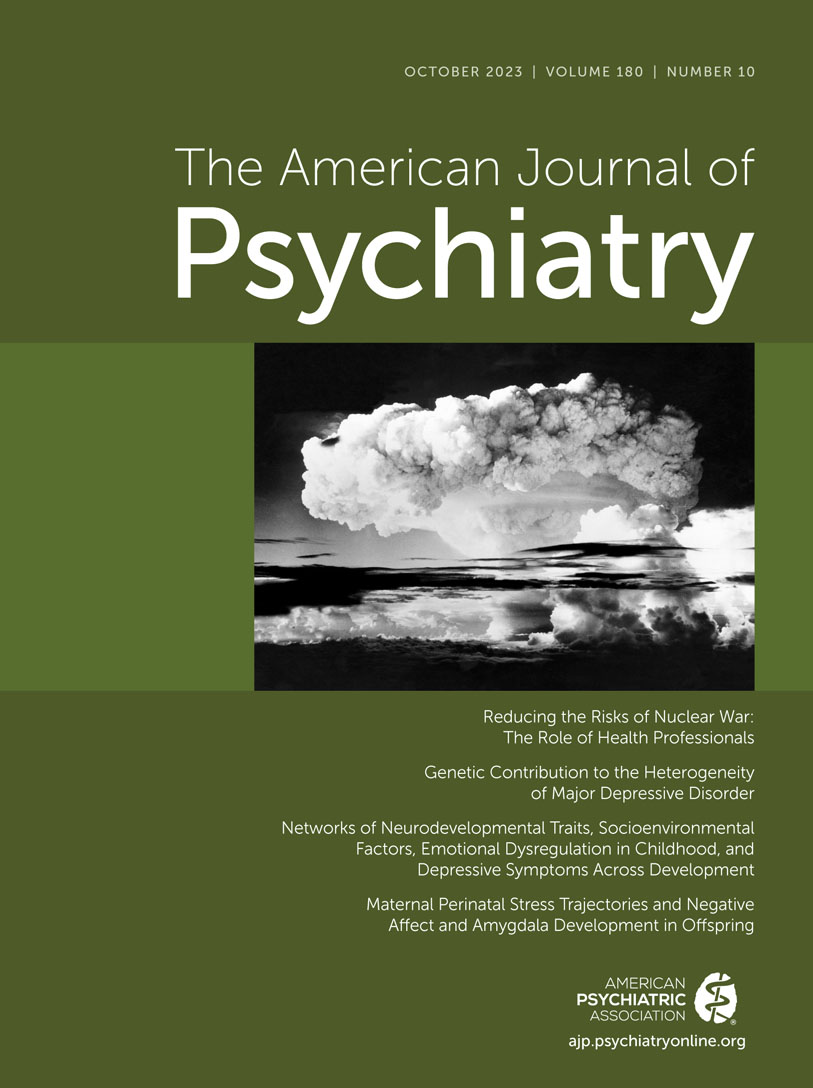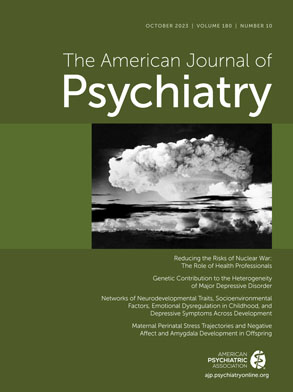Anxiety and depression—the internalizing disorders—typically emerge in the first three decades of life (
1,
2). They are among the most prevalent and burdensome mental illnesses, affecting ∼580 million individuals worldwide (
3,
4). In the United States, nearly one in three individuals will experience an anxiety disorder in their lifetime (
5), and one in five will experience a depressive disorder (
6). Direct spending on anxiety and depression treatment exceeds $100 billion annually (
7). Existing treatments are far from curative for many, fueling the search for new etiological insights and new targets for intervention (
8–
14).
The roots of internalizing illness extend into the earliest chapters of human development, when the brain and behavior are likely most plastic. There is ample evidence that caregiver behavior in the first half decade of life can have a profound and enduring impact on both neurobiological and psychological development and, ultimately, on lifelong health and well-being (
15–
17). The consistent provision of supportive, sensitive, and engaged care is essential for healthy emotional development and provides a buffer against the potentially toxic effects of childhood challenges, setbacks, and adversities (
15,
18). Not surprisingly, clinicians and researchers have shown a long-standing interest in understanding the role of parents and other caregivers in the development, treatment, and prevention of internalizing disorders (
16). Recent work highlights the potentially important role of perinatal caregiver stress in promoting child psychopathology, but the exact nature of this association remains unclear (
15,
19).
From this perspective, the new report from Marr and colleagues in this issue of the
Journal is a welcome addition to the literature (
20). Leveraging a composite index of maternal stress that was repeatedly assessed across pregnancy and the early postnatal period in a small but demographically diverse sample of American mothers (N=115), the authors used an innovative machine-learning approach and identified—in a completely data-driven way—six distinct patterns of perinatal maternal stress (
21). Two of the patterns predominantly reflected overall differences in stress severity, effectively clustering the mothers into groups with comparatively high or low levels of stress. The other four patterns reflected differences in the temporal dynamics of perinatal stress. Here, the mothers were split into groups characterized by distinct stress trajectories, including a middle-pregnancy peak (trajectory 2), a late-pregnancy peak (trajectory 1), a middle- and late-pregnancy trough (trajectory 3), and an inverted-U-shaped pattern (trajectory 4). Follow-up analyses demonstrated that the four stress-trajectory groups were demographically indistinguishable, suggesting that this novel classification might provide a useful additional source of information about children’s early-life experience. But are the trajectories a reproducible feature of maternal experience or simply an idiosyncratic feature of the data at hand? A key strength of Marr and colleagues’ study was the use of a second, much larger sample of Finnish mothers (N=2,156) to address this key question. Of the four stress trajectories identified in the U.S. sample, trajectories 1, 2, and 3 were replicated in the Finnish sample.
To clarify the consequences of mothers’ perinatal stress on their infant’s emotional development, Marr and colleagues modeled prospective associations between the replicable stress patterns and longitudinal measures of infant negative emotionality that were acquired over the first 2 years of life (
22). Negative emotionality is a particularly interesting phenotype because children who are prone to feelings of fear, irritability, and sadness are more likely to develop internalizing disorders and other forms of psychopathology as they age (
16,
23–
25). Latent growth curve analyses indicated that the average level of infant negative emotionality showed a developmentally appropriate increase across the first year of life, before declining in the second (
26). Among the stress patterns examined, trajectory 3 (a trough in maternal stress during middle and late pregnancy) was uniquely associated with longitudinal changes in negative emotionality of the offspring. Follow-up analyses demonstrated that the infants of mothers in the trajectory 3 group showed significantly lower levels of negative emotionality than those in the other groups by the end of their first year. Consistent with the American results, the offspring of mothers in Finland with the same longitudinal pattern of stress (trajectory 3) showed consistently dampened levels of negative emotionality across their first 2 years, with the differences reaching significance at ages 6, 12, and 24 months. In short, American and Finnish mothers reporting a trough in stress during the middle and late stages of pregnancy gave birth to children with lower levels of dispositional fear, shyness, anger, and sadness as infants and toddlers, and this prospective association could not be explained by demographic confounders, the average severity of maternal stress experienced during pregnancy, or the intensity of maternal stress during the postpartum follow-up period. These observations—which capitalize on over 2,000 families, drawn from two continents and intensively studied for nearly 3 years—motivate the hypothesis that diminished levels of maternal stress in the later stages of pregnancy foster the development of children who are less likely to develop emotional disorders later in life. These findings reinforce the idea that “timing matters” when it comes to early-life stress and are well aligned with recent commentaries emphasizing the importance of parsing heterogeneity in both the nature and the developmental timing of stress for understanding psychopathology (
15,
27–
30).
At first blush, Marr and colleagues’ findings seem to reinforce calls for an increased investment in interventions aimed at strengthening early-life caregiving and maternal well-being (
15), but they also raise questions about whom to target. On the one hand, across the six perinatal stress patterns identified by Marr’s team, only trajectory 3—experienced by less than a quarter of the American mothers (22.6%)—was consistently associated with variation in offspring temperament, after controlling for ongoing levels of postpartum maternal stress. On the other hand, in analyses that did not control for postpartum maternal stress, the overall severity of perinatal stress was associated with significantly elevated infant negative emotionality. Taken together, these findings suggest that mothers who report chronically high levels of stress, either before or after giving birth, have children who are at greater risk for developing emotional disorders. The latter results are consistent with a wealth of other work and motivate the development and refinement of targeted, universal, and public-policy interventions (
15,
19). Of course, as in nearly all prospective, longitudinal research studies, Marr and colleagues’ observations do not permit causal inferences. In addition to their immense practical value, well-designed intervention studies would afford a crucial opportunity to test whether reducing mothers’ perinatal stress is associated with positive consequences for infant temperament and, ultimately, mental health.
Marr and colleagues’ results raise a host of challenging questions for future research. Are the observed changes in early-life temperament associated with meaningful differences in the children’s emotional health in adolescence and emerging adulthood? Are the offspring of mothers who experience the middle- and late-pregnancy trough in stress, for instance, less likely to develop internalizing disorders? How exactly might subtle nuances in the dynamics of perinatal stress shape children’s early-life emotional development? Are similar associations evident for fathers? To what extent are these prospective phenotypic associations a consequence of genetic confounding (
31–
33)? What exactly is meant by “stress” in this context? After all, the composite index of perinatal stress used in the American sample reflected a mixture of mood and anxiety symptoms; neuroticism; perceptions of uncertainty, uncontrollability, and overloading; difficulties coping with or regulating distress; and exposure to strains, hassles, and negative life events. Unpacking this conceptual complexity and demonstrating incremental validity over straightforward measures of maternal temperament and internalizing symptoms are important avenues for future research (
34).
From a neurobiological angle, we might wonder how maternal stress “gets under the skin” to shape the development of the neural circuitry underlying negative emotionality in the offspring. Marr and colleagues provide a preliminary answer to this question. Leveraging fMRI data collected from a subset of the American infants at 1 month of age, they investigated potential differences in the intrinsic functional connectivity of the amygdala. The amygdala is particularly relevant because it is implicated in the development of anxiety and depression (
35–
37), is thought to mediate the impact of early-life adversities on negative emotionality (
38), and shows a protracted course of postnatal development (
39,
40). Among other findings, Marr and colleagues’ results suggest that the infants of mothers experiencing a trough in stress during middle and late pregnancy (trajectory 3) showed stronger functional connectivity between the amygdala and the ventromedial prefrontal cortex, a region thought to play a mechanistically important role in processing safety cues; biasing the amygdala; and regulating fear, anxiety, and other negative emotions (
41). This prospective association between maternal stress and infant brain function remained significant while controlling for the overall severity of perinatal stress, the other three maternal stress trajectories, and nuisance variance in gestational age at birth and infant age at the time of scanning. Collecting usable fMRI data from children is notoriously difficult, and the authors are to be commended for what was, in all likelihood, a Herculean scientific exercise (
42). Nevertheless, it is clear that these findings—which capitalize on just 5.5 minutes of imaging data acquired from 60 infants who were further categorized, on the basis of their mothers’ perinatal stress patterns, into six subgroups (N=9–32) (M. Marr, personal communication, July 16, 2023)—represent a provisional hypothesis that will need to be rigorously replicated in larger and more nationally representative samples (
43,
44). Addressing this challenge is likely to be facilitated by pooling data via new or existing biobanks (e.g., Healthy Brain and Child Development Study [HBCD]) or research consortia (e.g., Enhancing Neuroimaging Genetics Through Meta-Analysis [ENIGMA]). It is also worth remembering that the amygdala is a heterogeneous collection of nuclei linked by a network of microcircuits (
45). Understanding the relevance of the amygdala to early-life stress and psychiatric risk requires that future studies more fully embrace this neuroanatomical complexity. Adopting more precise definitions of stress (
46–
48) and developing integrative cross-species models will also be crucial for understanding the molecular and cellular mechanisms that link variation in maternal experience to childhood mental health and disease (
49–
52).
Internalizing symptoms, diagnoses, and treatment seeking are surging among youths and young adults (
53–
56), drawing the attention of clinicians, scientists, insurers, and policymakers—from the Surgeon General to the President of the United States (
57–
59). Although the underlying mechanisms remain elusive, Marr and colleagues’ study underscores the importance of developing a more complete understanding of the role that perinatal stress plays in the development of internalizing illness. Addressing this challenge will require a greater emphasis on mechanistically informative studies—including intervention, quasi-experimental, and genetic approaches—and the investment of resources commensurate with the established importance of children’s early emotional development for their lifelong health and well-being (
15–
17,
33,
60).
Acknowledgments
The authors acknowledge assistance and critical feedback from K. DeYoung, E. Fried, L. Friedman, H. Goldsmith, G. Hancock, N. Kalin, M. Marr, and J. Smith.

